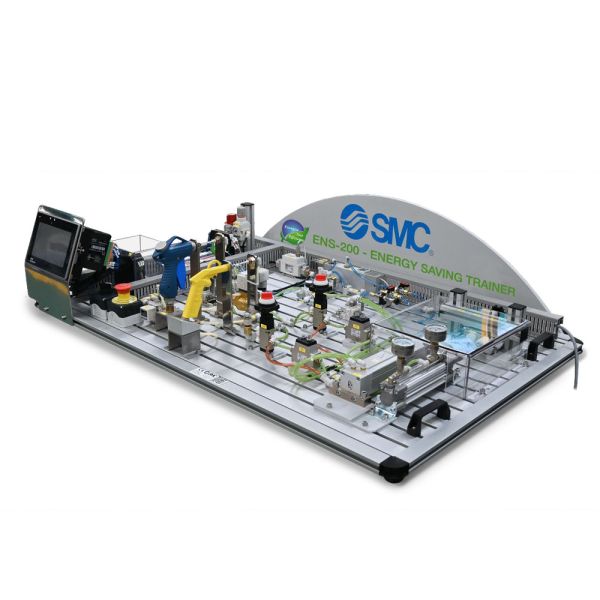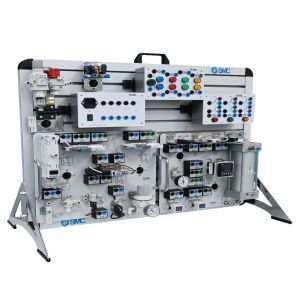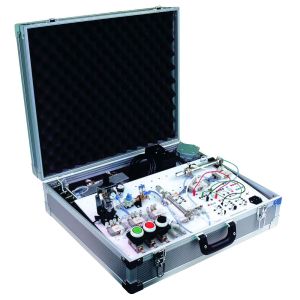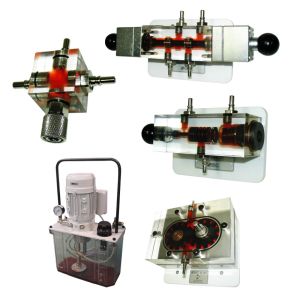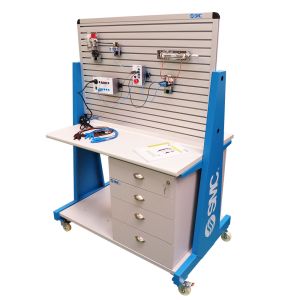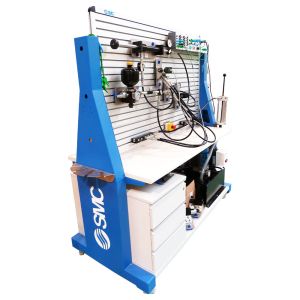Specifications are subject to change without prior notice.
ENS-200 - Energy saving trainer
Categories: T Levels & Engineering , T Levels & Engineering , Featured New , SMC Technology Trainers , Pneumatics Trainers
Energy saving trainer. ENS-200 integrates a series of applications (vacuum, actuators and blowing) aimed at knowing and implementing the methodology associated to energy saving in compressed air installations.
Top Key Features:
- Covers the 4 fundamental pillars of energy saving
- Includes an HMI (Human machine interface) with built in PLC
- Identifies potential savings and verifies their subsequent application
- Facilitates comparing the effects of adjusting the operating pressure
- Activities for quantifying advantages of positioning pressure controllers in each area
Overview
Energy saving trainer. ENS-200 integrates a series of applications (vacuum, actuators and blowing) aimed at knowing and implementing the methodology associated to energy saving in compressed air installations.
ENS-200 teaches you how to detect possible excessive consumption and suggest actions to prevent it.
Users will analyse different scenarios through a series of guided activities. Each experiment shows how much has been saved, both as a percentage and in the chosen currency.
Key Features:
- Covers the 4 fundamental pillars of energy saving
- Includes an HMI (Human machine interface) with built in PLC
- Identifies potential savings and verifies their subsequent application
- Facilitates comparing the effects of adjusting the operating pressure
- Activities for quantifying advantages of positioning pressure controllers in each area
- Activities for quantifying the effects of leaks on the consumption and size of the compressor
- Monitoring for machine consumption falls within expected limits
- Monitoring for detecting and locating leaks
- Compare different types of vacuum ejectors
- Comparison of various types of blow guns, different types of blow nozzles and actuators
- Analysis of impact using excessively long pipes, and negative effects of excessive pressure on pneumatic facilities
Dimensions
| Dimensions: | 1200 x 775 x 300 mm |
|---|
Technical Specifications
| ENS-200 1200 x 775 x 300 mm | MODULES | SENSORS (type & qty) | INPUT / OUTPUT |
| Vacuum area Actuator area Blowing area Control area | Pressure switch (x2) Vacuum switch (x1) Flowmeter (x1) Load cell (x1) | Digital 6/13 Analog 4/0 | |
| ACTUATORS (type & qty) | OTHER DEVICES (qty) | ||
| Pneumatic linear (x2) Blow gun (x2) Vacuum pad (x1) Venturi type vacuum ejector (x1) Multistage vacuum ejector with hysteresis function (x1) | 2/2 cutoff valve (x1) Solenoid valve block (x3) Manual 5/2 valve with selector switch (x2) Pressure regulator with pressure gauge (x1) Bicolour pressure gauge (x2) Flow regulator - leakage simulator (x2) Pressure/Flow regulator (x2) OR flow control valve (x2) Blower nozzles (x5) Manual valve (x2) Power supply (x1) | ||
PRESSURE
Pneumatic components must be set to just the right pressure. Avoid excessive pressure as consumption is proportional to work pressure..
SECTORISATION
To sectorise means to divide. It is possible to sectorise by differentiating between zones with different working pressure levels. It is also possible to sectorise by area, thereby minimising the impact of leaks when a zone is not active.
MONITORING
Monitoring means to measure. Measuring makes it possible to locate defects in the facility and assess what can be saved by correcting them. Measuring can be done constantly or occasionally. Monitoring also leads to prevention, i.e. knowing when a part of the facility is beginning to consume more energy due to leaks or other faults
AIR QUALITY
A dirty filter generates a drop in pressure. If this filter is not replaced, the pressure must be raised to continue meeting system requirements. This poor practice has a negative impact on consumption which leads to more compressed air generation
Kits
| REF | DESCRIPTION |
| SAI-7002 | ENS-200. Energy saving trainer |
How to use it:
ENS-200 includes an HMI (Human Machine Interface) with a built-in PLC, interactive menus guide the user through the different activities.
The system sets up all of the parameters automatically for each exercise.
The results from measuring consumption and the savings obtained are presented as a percentage and in monetary savings.
There are currently no files available for download

